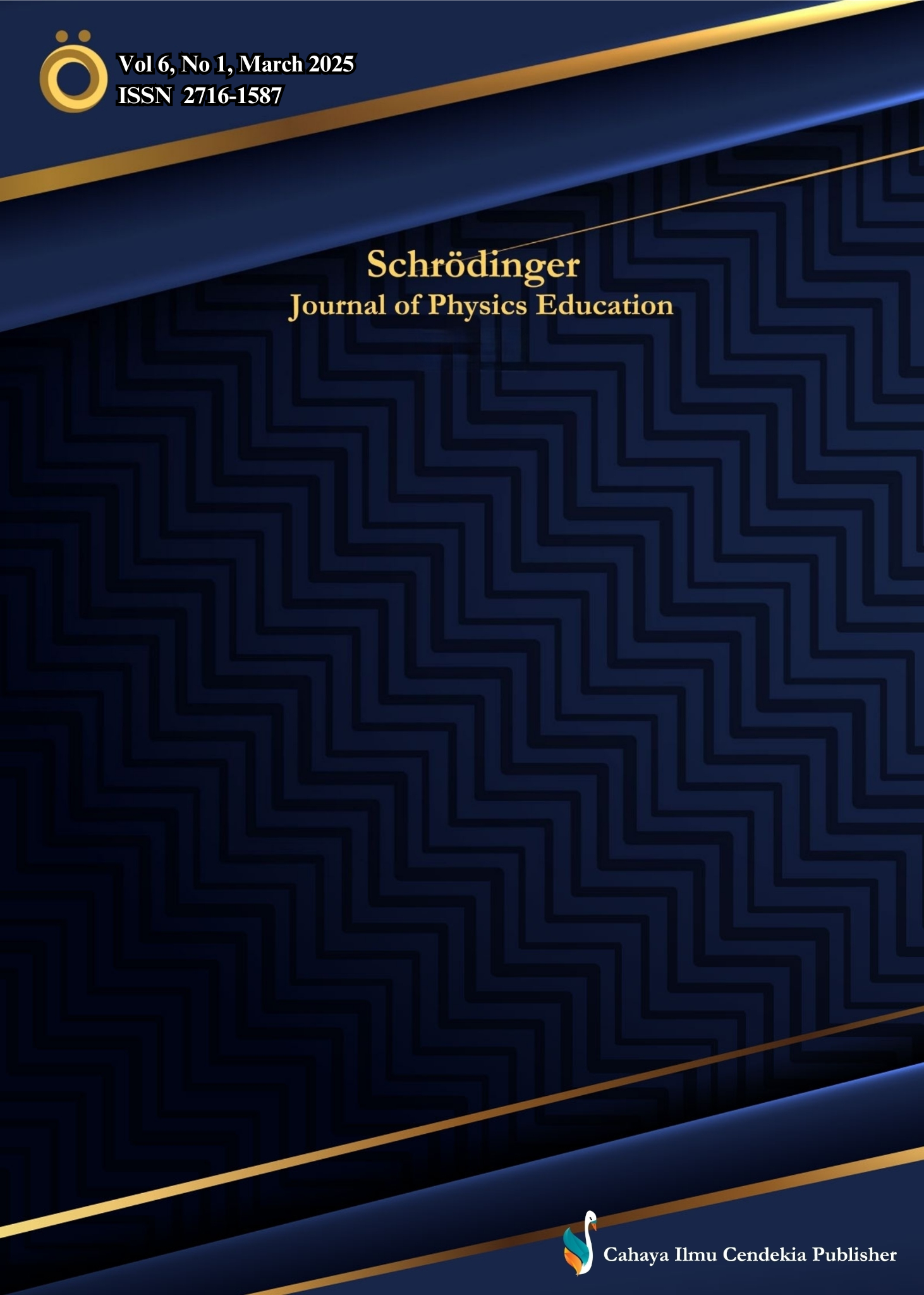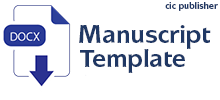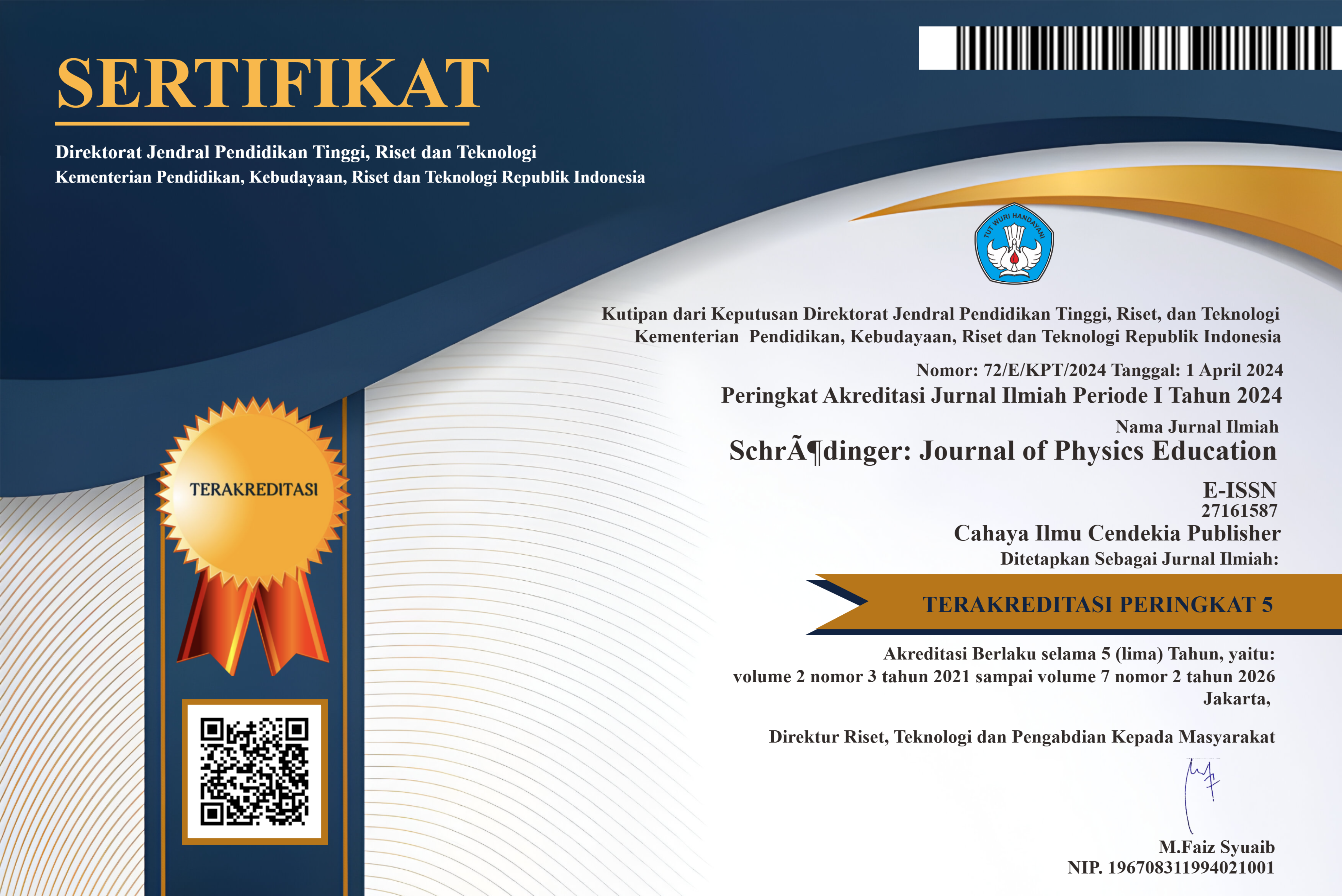Qualitative Analysis of the Implementation of Inquiry-Based Physics Learning Tools on Strengthening Character and Improving Learning Outcomes
Abstract
Purpose of the study: This study aims to analyze the implementation of inquiry-based physics learning devices to support character strengthening and improve student learning outcomes.
Methodology: This study uses a qualitative approach with a case study design. The subjects of the study were students and teachers of grade XI majoring in natural sciences 2 of Sleman 2 State Senior High School, selected using purposive sampling technique. Data were collected through observation, interviews, and document analysis. Data analysis used the Miles and Huberman model with data reduction, data display, and drawing conclusions through triangulation.
Main Findings: Inquiry-based learning increases students' active engagement, understanding of physics concepts, and critical thinking skills. Students are more independent, creative, and demonstrate positive character traits such as honesty, discipline, and cooperation. Test results show significant improvements in academic achievement. This approach is effective in supporting character building and the development of 21st-century skills according to the Merdeka Curriculum.
Novelty/Originality of this study: This study reveals the effectiveness of inquiry-based physics learning devices not only in improving learning outcomes, but also in building students' character. This study provides new insights into the integration of character building in physics learning, in line with the Merdeka Curriculum, and shows how the inquiry approach can develop 21st century skills more holistically.
References
M. Chekour, Y. Z. Seghroucheni, M. A. Tadlaoui, and M. M. Hafid, “Blended Learning and Simulation for Teaching Electrical Concepts to High School Pupils,” J. Turkish Sci. Educ., vol. 19, no. 4, pp. 1119–1134, 2022, doi: 10.36681/tused.2022.165.
W. T. Wulandari, “Contextual learning approach : development of worksheet in physics subjects,” Schrödinger J. Phys. Educ., vol. 4, no. 2, 2023, doi: 10.37251/sjpe.v4i2.506.
M. M. Zeidan and D. Young, “Enhancing classroom engagement : investigating student motivation towards learning physics,” SchrödingerJournal Phys. Educ., vol. 5, no. 4, pp. 150–159, 2024, doi: 10.37251/sjpe.v5i4.1288.
T. Bouchée, L. de Putter - Smits, M. Thurlings, and B. Pepin, “Towards a better understanding of conceptual difficulties in introductory quantum physics courses,” Stud. Sci. Educ., vol. 58, no. 2, pp. 183–202, 2022, doi: 10.1080/03057267.2021.1963579.
C. Hankeln, U. Kroehne, L. Voss, and S. Gross, “Developing digital formative assessment for deep conceptual learning goals : Which topic ‑ specific research gaps need to be closed ?,” Educ. Technol. Res. Dev., no. 0123456789, 2025, doi: 10.1007/s11423-025-10486-x.
R. Rizaldi, U. H. S, S. Fitriana, and T. A. Mardiana, “Effectiveness of Cooperative Problem Solving ( CPS ) learning with the science process skills approach on the subject of simple harmonic motion,” SchrödingerJournal Phys. Educ., vol. 5, no. 4, pp. 174–179, 2024, doi: 10.37251/sjpe.v5i4.1377.
A. Marougkas, C. Troussas, A. Krouska, and C. Sgouropoulou, “Virtual reality in education: a review of learning theories, approaches and methodologies for the last decade,” Electron., vol. 12, no. 13, 2023, doi: 10.3390/electronics12132832.
H. J. Cho, K. Zhao, C. R. Lee, D. Runshe, and C. Krousgrill, “Active learning through flipped classroom in mechanical engineering: improving students’ perception of learning and performance,” Int. J. STEM Educ., vol. 8, no. 1, 2021, doi: 10.1186/s40594-021-00302-2.
I. Furqon, M. W. Afgani, J. K. Putri, and F. Mabruroh, “Development of computer-based learning media on collision lesson using the context of traditional marbles game,” SchrödingerJournal Phys. Educ., vol. 5, no. 4, pp. 124–134, 2024.
E. G. A. Tolba and A. M. Al-Osaimi, “The effectiveness of using the model-based thinking strategy in developing first-grade high school students’ physical concepts and inquiry thinking skills,” Eurasia J. Math. Sci. Technol. Educ., vol. 19, no. 4, 2023, doi: 10.29333/EJMSTE/13111.
A. N. Fauziyah, M. Ramadan, P. R. Gumede, and I. N. Udosen, “Development of digital book bilingual physics learning media using kvisoft flipbook for high school class X semester 1 subject of newton’s law,” J. Educ. Technol. Learn. Creat., vol. 1, no. 1, pp. 7–15, 2023, doi: 10.37251/jetlc.v1i1.618.
C. J. Bogador, M. K. G. Camarao, C. G. Matunding, and K. J. F. Sombria, “Challenges and benefits of inquiry-based learning in physics,” Int. J. Multidiscip. Appl. Bus. Educ. Res., vol. 5, no. 7, pp. 2716–2732, 2024, doi: 10.11594/ijmaber.05.07.26.
Lukman et al., “Effective teachers’ personality in strengthening character education,” Int. J. Eval. Res. Educ., vol. 10, no. 2, pp. 512–521, 2021, doi: 10.11591/ijere.v10i2.21629.
V. Lungu, L. CretuTa, M. Munteanu, and L. Sadovei, “The place of social and moral values in the high school curriculum from the republic of moldova,” J. Ilm. Ilmu Terap. Univ. Jambi, vol. 9, no. 1, pp. 87–103, 2025, doi: 10.22437/jiituj.v9i1.38082.
K. A. A. Gamage, D. M. S. C. P. K. Dehideniya, and S. Y. Ekanayake, “The role of personal values in learning approaches and student achievements,” Behav. Sci. (Basel)., vol. 11, no. 7, 2021, doi: 10.3390/bs11070102.
M. Sulaiman, Y. Latifah, Y. Deneri, and J. R. Gonzales, “Exploring character dynamics : unveiling dominant values in physics education,” SchrödingerJournal Phys. Educ., vol. 5, no. 2, pp. 46–52, 2024, doi: 10.37251/sjpe.v5i2.964.
D. R. Rizaldi, E. Nurhayati, and Z. Fatimah, “The correlation of digital literation and STEM integration to improve indonesian students’ skills in 21st century,” Int. J. Asian Educ., vol. 1, no. 2, pp. 73–80, 2020, doi: 10.46966/ijae.v1i2.36.
N. Yunaini, M. Prabowo, N. Hassan, and A. Kichi, “The concept of the independent learning curriculum ( merdeka belajar ) in elementary schools in view progressivism educational philosophy,” JIP (Jurnal Ilm. PGMI), vol. 8, no. 2, pp. 95–105, 22AD.
S. Sukarno, K. T. Win, and D. A. C. Hong, “Teachers’ views regarding the character of students’ perseverance in science learning,” Integr. Sci. Educ. J., vol. 5, no. 1, pp. 59–64, 2024, doi: 10.37251/isej.v5i1.806.
I. A. Rizki et al., “Cooperative model, digital game, and augmented reality-based learning to enhance students’ critical thinking skills and learning motivation,” J. Pedagog. Res., vol. 8, no. 1, pp. 339–355, 2024, doi: 10.33902/JPR.202423825.
J. Watters, “Why Is It So? Interest and Curiosity in Supporting Students Gifted in Science BT - Handbook of Giftedness and Talent Development in the Asia-Pacific,” S. R. Smith, Ed., Singapore: Springer Singapore, 2021, pp. 761–786. doi: 10.1007/978-981-13-3041-4_34.
J. M. P. Sanchez, “Teaching motion concepts through pokémon unite : atudents ’ acceptance and experiences,” SchrödingerJournal Phys. Educ., vol. 5, no. 3, pp. 98–106, 2024, doi: 10.37251/sjpe.v5i3.1076.
Q.-F. Yang, H. Lin, G.-J. Hwang, P.-Y. Su, and J.-H. Zhao, “An exploration-based SVVR approach to promote students’ chemistry learning effectiveness,” Interact. Learn. Environ., vol. 32, no. 5, pp. 2003–2027, May 2024, doi: 10.1080/10494820.2022.2135106.
E. Triani, Maison, and Nazarudin, “Diagnosing students ’ misconceptions of direct current electrical circuits using a five-tier isomorphic instrument,” J. Ilm. Ilmu Terap. Univ. Jambi, vol. 9, no. 1, pp. 71–86, 2025, doi: 10.22437/jiituj.v9i1.40469.
A. Žerovnik and I. Nančovska Šerbec, “Project-Based Learning in Higher Education BT - Technology Supported Active Learning: Student-Centered Approaches,” C. Vaz de Carvalho and M. Bauters, Eds., Singapore: Springer Singapore, 2021, pp. 31–57. doi: 10.1007/978-981-16-2082-9_3.
E. Wati, J. Kigo, and K. Inthaud, “Positive impact of the local wisdom module on the canang kayu musical instrument : building the character of love for the homeland,” SchrödingerJournal Phys. Educ., vol. 5, no. 1, 2024, doi: 10.37251/sjpe.v5i1.905.
T. P. Socrates, R. Afrizon, H. Hidayati, and R. Hidayat, “The Needs Analysis for an Educational Physics Game with Scientific Literacy and Ethnoscientific Content,” J. Pendidik. Fis. dan Teknol., vol. 9, no. 1, pp. 151–162, 2023, doi: 10.29303/jpft.v9i1.5079.
M. S. Bolger, J. B. Osness, J. S. Gouvea, and A. C. Cooper, “Supporting scientific practice through model-based inquiry: A students’-eye view of grappling with data, uncertainty, and community in a laboratory experience,” CBE Life Sci. Educ., vol. 20, no. 4, pp. 1–22, 2021, doi: 10.1187/cbe.21-05-0128.
T. de Jong et al., “Let’s talk evidence – the case for combining inquiry-based and direct instruction,” Educ. Res. Rev., vol. 39, no. November 2022, p. 100536, 2023, doi: 10.1016/j.edurev.2023.100536.
F. Özer and D. Sarıbaş, Exploring Pre-service Science Teachers’ Understanding of Scientific Inquiry and Scientific Practices Through a Laboratory Course, vol. 32, no. 3. Springer Netherlands, 2023. doi: 10.1007/s11191-022-00325-3.
Y. Wen et al., “Integrating augmented reality into inquiry-based learning approach in primary science classrooms,” Educ. Technol. Res. Dev., vol. 71, no. 4, pp. 1631–1651, 2023, doi: 10.1007/s11423-023-10235-y.
D. K. Dewi, W. Ardhana, Irtadji, T. Chusniyah, and A. Sulianti, “Inquiry-based learning implementation to improve critical thinking of prospective teachers,” Int. J. Inf. Educ. Technol., vol. 11, no. 12, pp. 638–645, 2021, doi: 10.18178/IJIET.2021.11.12.1575.
T. D. Nur, A. D. Corebima, S. Zubaidah, I. Ibrohim, and M. Saefi, “Biology through thinking empowerment by questioning: the effect on conceptual knowledge and critical thinking,” Particip. Educ. Res., vol. 10, no. 1, pp. 122–139, 2023, doi: 10.17275/per.23.7.10.1.
K. Ay and G. Dağhan, “The effect of the flipped learning approach designed with community of inquiry model to the development of students’ critical thinking strategies and social, teaching and cognitive presences,” Educ. Inf. Technol., vol. 28, no. 11, pp. 15267–15299, 2023, doi: 10.1007/s10639-023-11809-2.
X. Yang, M. Zhang, Y. Zhao, Q. Wang, and J.-C. Hong, “Relationship between creative thinking and experimental design thinking in science education: Independent or related,” Think. Ski. Creat., vol. 46, p. 101183, 2022, doi: https://doi.org/10.1016/j.tsc.2022.101183.
A. A. Ogegbo and U. Ramnarain, “Teaching and learning Physics using interactive simulation: A guided inquiry practice,” South African J. Educ., vol. 42, no. 1, pp. 1–9, 2022, doi: 10.15700/saje.v42n1a1997.
I. M. Astra, A. Henukh, and Algiranto, “Implementation of think pair share model in physics learning to determine cognitive, affective and psychomotor learning outcomes and student responses,” J. Phys. Conf. Ser., vol. 1876, no. 1, 2021, doi: 10.1088/1742-6596/1876/1/012064.
V. J. Owan et al., “Innate ability, health, motivation, and social capital as predictors of students’ cognitive, affective and psychomotor learning outcomes in secondary schools,” Front. Psychol., vol. 13, no. October, 2022, doi: 10.3389/fpsyg.2022.1024017.
M. Abbasi, M. Shirazi, H. Torkmandi, S. Homayoon, and M. Abdi, “Impact of teaching, learning, and assessment of medical law on cognitive, affective and psychomotor skills of medical students: a systematic review,” BMC Med. Educ., vol. 23, no. 1, pp. 1–15, 2023, doi: 10.1186/s12909-023-04695-2.
J. Schellinger, A. Mendenhall, N. Alemanne, S. A. Southerland, V. Sampson, and P. Marty, “Using Technology-Enhanced Inquiry-Based Instruction to Foster the Development of Elementary Students’ Views on the Nature of Science,” J. Sci. Educ. Technol., vol. 28, no. 4, pp. 341–352, 2019, doi: 10.1007/s10956-019-09771-1.
D. Yulianti, S. Khanafiyah, and S. Sulistyorini, “Inquiry-based science comic physics series integrated with character education,” J. Pendidik. IPA Indones., vol. 5, no. 1, pp. 38–44, 2016, doi: 10.15294/jpii.v5i1.5787.
N. A. Arisa, L. Hakim, and L. Lefudin, “Development of inquiry-based physics learning modules on linear motion materials for senior high school students,” Phys. Educ. Res. J., vol. 4, no. 1, pp. 41–50, 2022, doi: 10.21580/perj.2022.4.2.11188.
L. Hatch and S. K. Clark, “A study of the instructional decisions and lesson planning strategies of highly effective rural elementary school teachers,” Teach. Teach. Educ., vol. 108, p. 103505, 2021, doi: https://doi.org/10.1016/j.tate.2021.103505.
G. M. Geletu and D. M. Mihiretie, “Professional accountability and responsibility of learning communities of practice in professional development versus curriculum practice in classrooms: Possibilities and pathways,” Int. J. Educ. Res. Open, vol. 4, no. December 2022, p. 100223, 2023, doi: 10.1016/j.ijedro.2022.100223.
P. Guo, N. Saab, L. Wu, and W. Admiraal, “The Community of Inquiry perspective on students’ social presence, cognitive presence, and academic performance in online project-based learning,” J. Comput. Assist. Learn., vol. 37, no. 5, pp. 1479–1493, 2021, doi: 10.1111/jcal.12586.
N. Adhami and M. Taghizadeh, “Integrating inquiry-based learning and computer supported collaborative learning into flipped classroom: effects on academic writing performance and perceptions of students of railway engineering,” Comput. Assist. Lang. Learn., vol. 37, no. 3, pp. 521–557, 2024, doi: 10.1080/09588221.2022.2046107.
B. Caymaz and A. Aydin, “The Effect of Common Knowledge Construction Model-Based Instruction on 7th Grade Students’ Academic Achievement and Their Views about the Nature of Science in the Electrical Energy Unit at Schools of Different Socio-economic Levels,” Int. J. Sci. Math. Educ., vol. 19, no. 2, pp. 233–265, 2021, doi: 10.1007/s10763-020-10054-0.
Y. Ozdem-Yilmaz and K. Bilican, “Discovery Learning—Jerome Bruner BT - Science Education in Theory and Practice: An Introductory Guide to Learning Theory,” B. Akpan and T. J. Kennedy, Eds., Cham: Springer International Publishing, 2020, pp. 177–190. doi: 10.1007/978-3-030-43620-9_13.
A. L. Reschly and S. L. Christenson, Handbook of Research on Student Engagement. Switzerland: Springer Cham, 2022. doi: 10.1007/978-3-031-07853-8.
Copyright (c) 2025 Silvina Anjar Sari, Nirawit Kunanta, Mohamed A Oransa

This work is licensed under a Creative Commons Attribution 4.0 International License.
Authors who publish with this journal agree to the following terms:
- Authors retain copyright and acknowledge that the Schrödinger: Journal of Physics Education is the first publisher licensed under a Creative Commons Attribution 4.0 International License.
- Authors are able to enter into separate, additional contractual arrangements for the non-exclusive distribution of the journal's published version of the work (e.g., post it to an institutional repository or publish it in a book), with an acknowledgment of its initial publication in this journal.
- Authors are permitted and encouraged to post their work online (e.g., in institutional repositories or on their website) prior to and during the submission process, as it can lead to productive exchanges and earlier and greater citation of published work.







.png)
.png)








.png)
.png)
.png)







